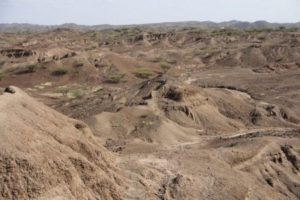
Just west of Lake Turkana in northwestern Kenya, the rocky, arid terrain of the desert badlands, like a southern New Mexico landscape, can wear a hiker down very quickly. Without ample water supply, dehydration becomes one’s worst enemy. Temperatures typically vary between 100 and 110 degrees Fahrenheit with little available shade. Venomous snakes and scorpions abound. Malaria is not uncommon among those who live and work here. For Sammy Lokorodi, a local Turkana tribesman who is a resident of these parts, this is a familiar and livable landscape. He is also, among other things, a fossil and artifact hunter. As an integral part of scientific field expeditions, he has been specially trained by experience to see and excavate fossils and artifacts that likely could be millions of years old, teasing them from a surrounding matrix of desert rock and soil that, to anyone with an untrained eye, would make them unrecognizable. On any given day, this would be routine for Lokorodi.
But one day in 2011, while working as a member of the field team for the West Turkana Archaeological Project (WTAP), he found himself front-and-center in a discovery that would end up raising new questions with far-reaching implications about the human evolutionary past.
“Our project has been working in this region of northern Kenya for 20 years, and in 2011 we made a plan to survey for early stone tools in very old sediments,” said Dr. Sonia Harmand, a French archaeologist and co-director of the WTAP project field team. “So on the morning of July 9,” she continued, “we were on the way to a particular survey zone, where Meave Leakey and her team found a hominin skull back in 1999.”
While driving in a dry riverbed, Harmand and her party came to a point where it branched off to the left and to the right. They chose the left branch. In time they could see, however, that they were off course. They were lost—but, as she and her colleagues soon discovered, they were lost in a very fortuitous way.
“Something was really unique about this place,” she said. “We could tell that this zone had a lot of hidden areas just waiting to be explored. So for an hour before teatime, while trying to head back to the main channel, we surveyed around and spotted a few strange rocks on the surface. We surveyed around a bit more intensely, and that’s when Sammy Lokorodi, one of our Turkana team members, called us over to the site where we found these oldest stone tools.”
A New Stone Tool Industry
“Oldest stone tools” turned out to be the operative phrase in this discovery. What they found, over two field seasons spanning 2011 and 2012, was an assortment of simple stone tools that exhibited characteristics unlike any they had ever seen before. In some ways they resembled the simplest stone tool industry known to date—that of the Oldowan, first discovered by Louis Leakey in the 1930’s at Olduvai Gorge in Tanzania. Those tools consisted of simple cores, choppers, scrapers, awls and burins made of quartz, quartzite, basalt, obsidian, flint and chert. Early humans produced them by striking a core stone on the edge with a hammerstone to produce a conchoidal fracture with sharp edges that could be used for a variety of functions, such as cutting meat. In some other ways, however, these newly found artifacts differed. By experimenting with the same stone material to replicate what they had found, the researchers concluded that these objects were something altogether distinct from that of the Oldowan. The “lithics (cores and flakes) are significantly larger in length, width, and thickness” than the Oldowan-type tools discovered at many other sites in eastern Africa, noted Harmand and her colleagues. “The dimensions and the percussive-related features visible on the artifacts suggest the hominins were combining core reduction and battering activities and may have used artifacts variously: as anvils, cores to produce flakes, and/or as pounding tools. The use of individual objects for several distinctive tasks reflects a degree of technological diversity both much older than previously acknowledged and different from the generally uni-purpose stone tools used by primates [such as using stones exclusively to crack open nuts].” The arm and hand motion employed in the production of the tools were somewhat less sophisticated than that employed in producing Oldowan tools, the researchers observed. “The “knappers’ understanding of stone fracture mechanics and grammars of action is clearly less developed than that reflected in early Oldowan assemblages……… the assemblage could represent a technological stage between a hypothetical pounding-oriented stone tool use by an earlier hominin and the flaking-oriented knapping behavior of later, Oldowan toolmakers.”*
In other words, what Harmand and her colleagues were looking at was an entirely new stone tool industry, previously unknown to the science. And though simpler or more “primitive” than that of the Oldowan, these were clearly not made or used by chimpanzees or some other primate. The “artifacts indicate that their makers’ hand motor control must have been substantial and thus that reorganization and/or expansion of several regions of the cerebral cortex (for example, somatosensory, visual, pre-motor and motor cortex), cerebellum, and of the spinal tract could have occurred,” stated Harmand and colleagues in the research report related to the discovery.*
By the end of the 2012 season, the artifact assemblage totaled 149 lithic objects in all, including “83 cores, 35 flakes (whole and broken), seven passive elements or potential anvils, seven percussors (whole, broken or potential), three worked cobbles, two split cobbles, and 12 artifacts grouped as indeterminate fragments or pieces lacking diagnostic attributes.”* They assigned them to a new lithic tool industry, the ‘Lomekwian’, named after the hill site where they were initially found, Lomekwi 3, or LOM3.
How were these stone tools used?
“This is the key question everyone is still trying to answer,” says Harmand. “Early members of our lineage surely first began making tools to solve a problem, but what problem that was remains unclear. Maybe they needed sharp flakes to cut or otherwise process new food resources, whether animal or vegetal. Maybe they were using the cores to pound open nuts or bones. In any case, this development was important because it represents the ability to modify our environment, to imagine tools that aren’t naturally there and make them from available raw materials, and use those tools to solve problems and better survive.”
_________________________________________
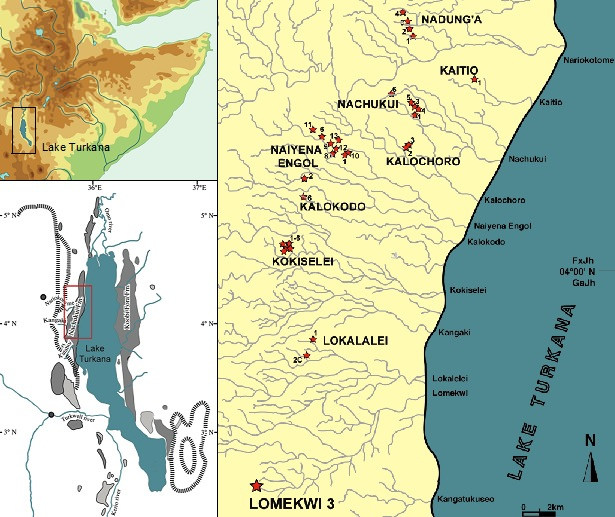 The mapped location of the Lomekwi site, just west of Lake Turkana in Kenya. Courtesy West Turkana Archaeological Project
The mapped location of the Lomekwi site, just west of Lake Turkana in Kenya. Courtesy West Turkana Archaeological Project
____________________________________
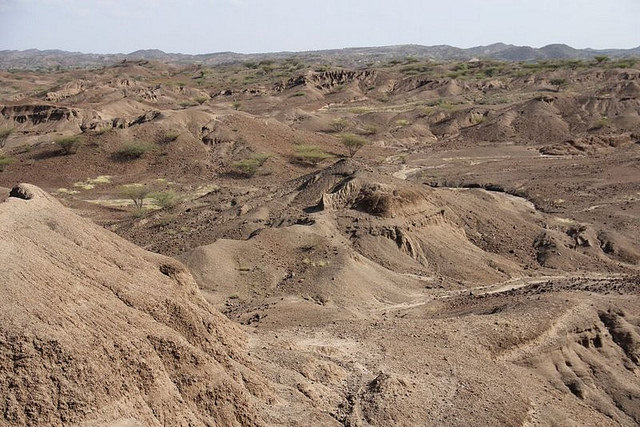 The Lomekwi site area is not unlike an American Southwest landscape. Courtesy MKW and West Turkana Archaeological Project
The Lomekwi site area is not unlike an American Southwest landscape. Courtesy MKW and West Turkana Archaeological Project
______________________________________________________
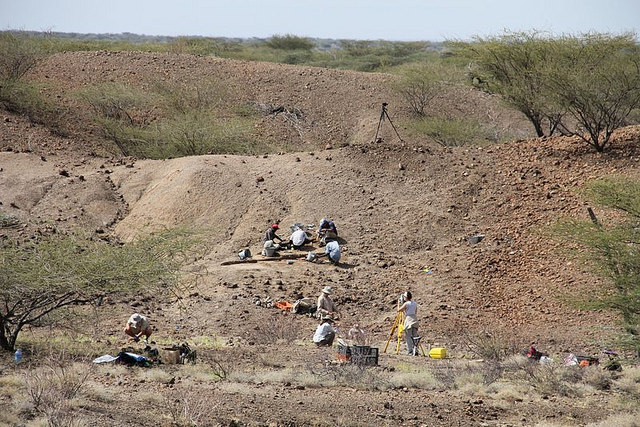 A general view of the excavation site. Courtesy MKW and West Turkana Archaeological Project
A general view of the excavation site. Courtesy MKW and West Turkana Archaeological Project
___________________________________________________
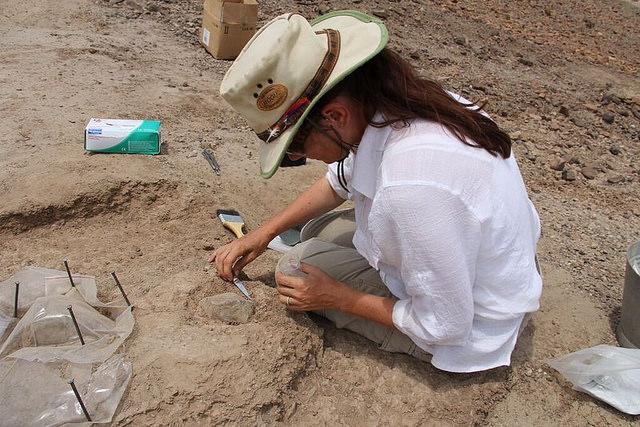 Sonia Harmand excavating a stone tool find. Courtesy MKW and West Turkana Archaeological Project
Sonia Harmand excavating a stone tool find. Courtesy MKW and West Turkana Archaeological Project
___________________________________________________
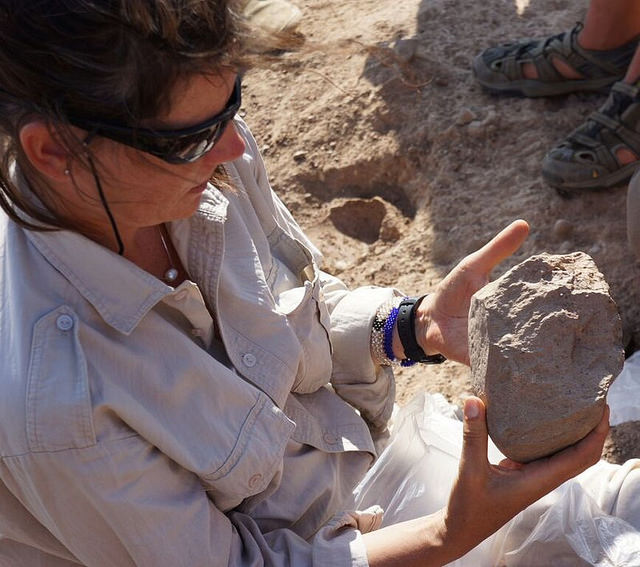 Sonia Harmand examines a stone tool, just unearthed. To the untrained eye, it looks like any stone, but to the scientists who know how and where to look, it bears the unmistakable signs of having been intentionally worked by hand in antiquity. Courtesy MKW and West Turkana Archaeological Project
Sonia Harmand examines a stone tool, just unearthed. To the untrained eye, it looks like any stone, but to the scientists who know how and where to look, it bears the unmistakable signs of having been intentionally worked by hand in antiquity. Courtesy MKW and West Turkana Archaeological Project
________________________________________________
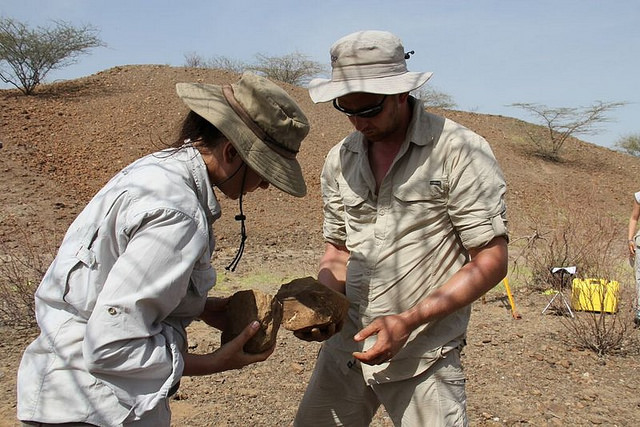 Project directors Sonia Harmand and Jason Lewis examine and compare stone tools just unearthed. How old are they? Courtesy MKW and West Turkana Archaeological Project
Project directors Sonia Harmand and Jason Lewis examine and compare stone tools just unearthed. How old are they? Courtesy MKW and West Turkana Archaeological Project
_______________________________________________
Before Oldowan
Though the finds were tantalizing by themselves, none of them would be more significant without their context in time.
The team called on Christopher Lepre, of the Department of Earth and Planetary Sciences, Rutgers University, to take a look at the contextual sediments of the finds. Arriving one week after the initial discovery, he collected samples of sediments from a series of different depths associated with the artifact locations. Returning to the Lamont-Doherty Earth Observatory lab at Columbia University, he worked closely with Dennis Kent to cut the samples into sugar cube-size blocks and place them into a magnetometer. This measured the polarity of key grains of minerals within the sediment known as hematite and magnetite, a record of the time periods in the past when the Earth’s magnetic field reversed itself. “We essentially have a magnetic tape recorder that records the magnetic field … the music of the [earth’s] outer core,” said Kent.
Comparing their measurements with the already-known chronology of those changes going back millions of years, they were able to determine the dating of the artifacts.
The results: These stone tools were between 3.33 and 3.11 million years old. That made them the oldest stone tools ever found.
Moreover, scientists were able to develop a picture of the environment in which the toolmakers must have lived. They did this by studying carbon isotopes in the sediments, conducting forty-seven isotopic analyses on eleven paleosol samples using a Micromass Optima mass spectrometer. They also examined the animal fossils recovered at the site.
What they found was surprising: These tools were fashioned in a partially wooded, shrubby environment. Not a dry savannah. It belied the broadly accepted evolutionary paradigm that toolmaking emerged at least in part due to adaptation by early humans to the spread of the dry, savannah grassland environment, analogs of which can still be seen today in the modern east African landscape.
The implications of these findings were enormous. It meant that there was a group of hominins living in a partly wooded, shrubby land who made simple stone tools before the Oldowan, the earliest examples of which were dated to about 2.6 million years ago and thought to have been made by hominins in the Homo line (more directly ancestral to modern humans) in a dry, savannah-like landscape.
So who were the Lomekwian toolmakers?
“It is unclear at the moment who the most likely maker of the tools was,” said Jason Lewis of Rutgers University, a lead researcher and lead author of the study. “We can be fairly certain it was a member of our lineage and not a fossil great ape, as modern apes have never been seen knapping stone tools in the wild. Which of the members of our lineage it was, however, remains to be determined. The most likely possibilities include Kenyanthropus platyops (the fossils of which are from just a few hundred meters from the LOM3 site), Australopithecus afarensis [the species best known through the famous Lucy discovery], or an as-yet undiscovered early member of the genus Homo.”
Kanyanthropus platyops, fossils of which were first discovered in 1999 by Justus Erusas, a member of the expeditionary team led by Meave Leakey, is considered by many scholars to be a hominin species that lived 3.2 – 3.5 million years ago in the Lake Turkana region. It is not yet certain whether Kenyanthropus belongs with the Homo genus or the Australopithecus genus, but its discovery has added to the growing consensus that there may indeed have been multiple species, and perhaps even multiple genera, of hominins living at roughly the same time. Early humans and their proto-human cousins may have been a diverse lot.
And there is already arguable evidence that even more primitive tool production and use was taking place even before LOM3. In 2009, a team of researchers at the site of Dikika in Ethiopia discovered 3.39 million-year-old animal bones featuring slash marks and other cut marks, evidence of intentional de-fleshing. It is considered the earliest possible evidence of hominins consuming meat and marrow. Although no tools were found at the site, it was clear that the marks were made by either sharp-edged stones or more finely crafted stone tools.
Who were the possible hominins responsible for the Dikika cut marks? Fossil remains of Australopithecus afarensis are (as of this writing) the only hominin fossils found in the area of Dikika dated to the same time period.
In any case, even if/when any additional hominin fossils are discovered at or near the LOM3 site, certainty about the identification of the toolmakers may continue to be elusive. As Lewis states, “it is extremely rare to be able to pinpoint what fossil species made which stone tools through most of prehistory, unless there was only one hominin species living at the time, or until we find a fossil skeleton still holding a stone tool in its hand.”
Most important of all, the LOM3 findings may require a re-thinking of what constitutes the ‘evolutionary divide’ between Homo, the genus that gave rise to us—Homo sapiens—and the more ape-like proto-human precursors known as the australopithecines.
“The idea was that our lineage alone took the cognitive leap of hitting stones together to strike off sharp flakes and that this was the foundation of our evolutionary success,” said Lewis. “This discovery challenges the idea that the main characters that make us human, such as making stone tools, eating more meat, maybe using language, etc, all evolved at once in a punctuated way, near the origins of the genus Homo. If the makers of the LOM3 tools were australopiths or some other non-Homo species, then that tells us some of these main traits were important for our lineage’s survival before the origins of Homo. If they were made by an even earlier and as-yet unknown member of the genus Homo, that’s a different but equally interesting story, in which our genus evolved half a million years before, and in response to completely different natural selective pressures, than we currently think.”
______________________________________
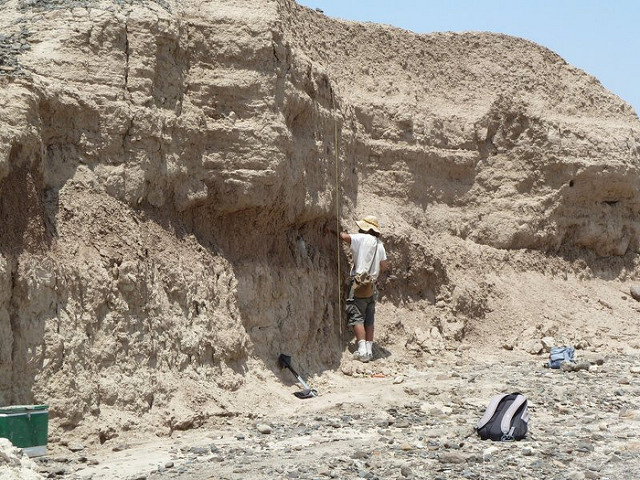 Chris Lepre of Columbia University’s Lamont-Doherty Earth Observatory (back to camera) precisely dated the artifacts by analyzing layers above, around and below them for reversals in earth’s magnetic field. Courtesy MKW and West Turkana Archaeological Project
Chris Lepre of Columbia University’s Lamont-Doherty Earth Observatory (back to camera) precisely dated the artifacts by analyzing layers above, around and below them for reversals in earth’s magnetic field. Courtesy MKW and West Turkana Archaeological Project
________________________________________________
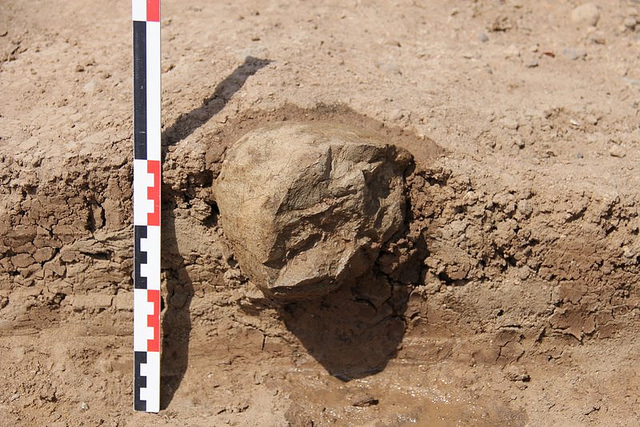 Above and below: A stone tool in situ, in the process of being excavated. Courtesy MKW and West Turkana Archaeological Project
Above and below: A stone tool in situ, in the process of being excavated. Courtesy MKW and West Turkana Archaeological Project
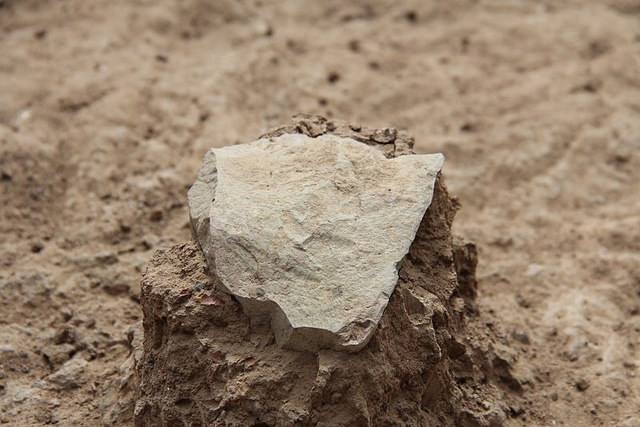 ________________________________________________
________________________________________________
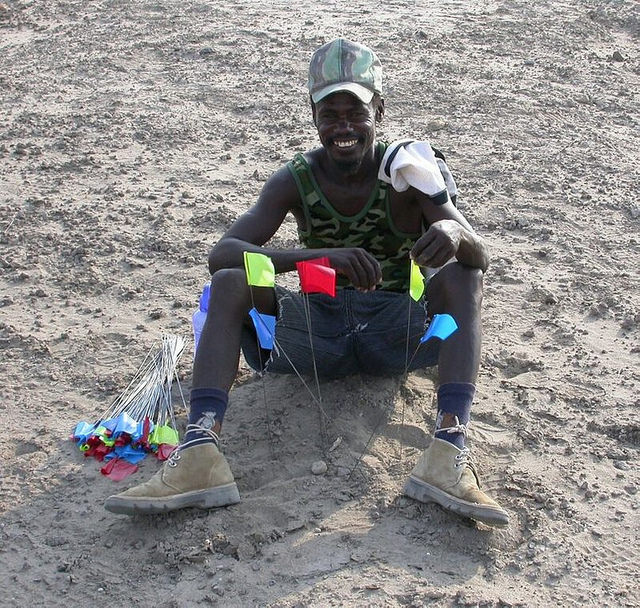 Sammy Lokorodi, who first found the Lomekwi 3 site. Courtesy MKW and West Turkana Archaeological Project
Sammy Lokorodi, who first found the Lomekwi 3 site. Courtesy MKW and West Turkana Archaeological Project
_______________________________________________
The Earliest Homo?
Hundreds of kilometers to the northeast of Lomekwi, another tantalizing new discovery was being made that, like the LOM3 finds, would push back the clock and raise new questions about human evolution. Along with a team of scientists led by Arizona State University’s Kaye E. Reed, ASU graduate student Chalachew Seyoum was conducting an assigned surveying task on a fossil-bearing hill in the Ledi-Geraru area of the Afar region of Ethiopia on January 29th, 2013. Something had attracted his attention on that day.
“After I climbed up the plateau,” he recalled, “I saw three molars sticking out of the sediment. I sat down and looked at it, and then I picked at it. There were three molars intact with a piece of mandible [lower jaw bone].”
Examining the find further, he could see that there was a “fresh break”, a place where it had been broken away from the body of the rest of the fossil. Thinking that perhaps it was nearby, he began to search for it. “Eventually I found the other piece and I pieced them back together. They fit perfectly. We found more broken pieces of a crown in the same spot.”
The initial discovery led to dry sieving, and the team was able to piece together a relatively ‘complete’ partial 8- cm.-long mandible with five intact teeth, representing the left side of a lower jaw.
Analysis of the fossil, led by Brian Villmoare and William H. Kimbel of ASU’s Institute of Human Origins, revealed features such as slim molars, symmetrical premolars and an evenly proportioned jaw, characteristics that have distinguished species of the Homo lineage from the more apelike characteristics of Australopithecus, the genus of which one species is suggested by many scholars to have been a forerunner of the Homo genus. Yet some features of the Ledi-Geraru mandible, such as a more primitive, sloping chin morphology, is similar to that of the Australopithecines.
_________________________________
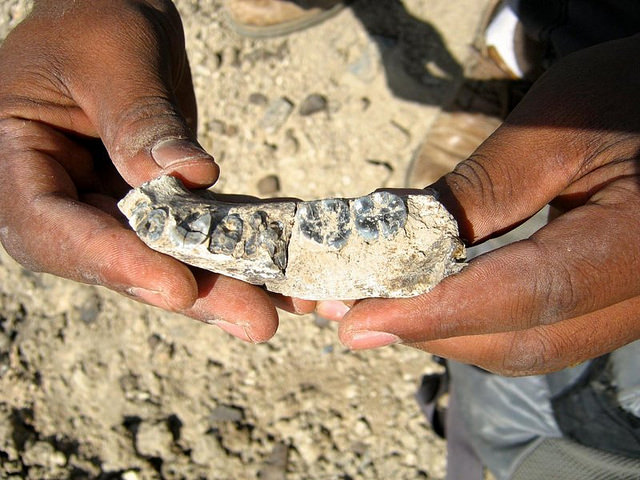 Close-up view of the Ledi-Geraru partial mandible close to where it was sighted. Credit: Kaye Reed
Close-up view of the Ledi-Geraru partial mandible close to where it was sighted. Credit: Kaye Reed
___________________________________________
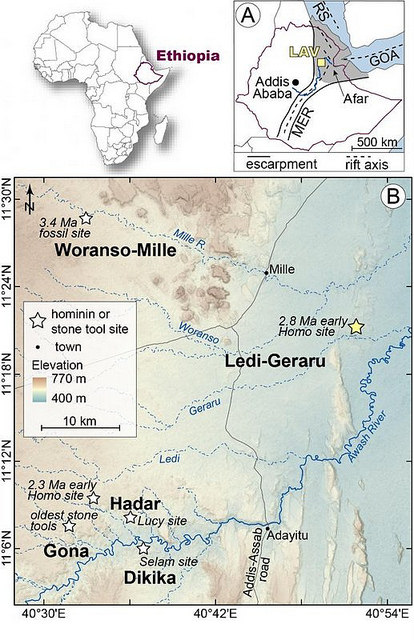 Detailed map of where the Ledi-Geraru site is located in reference to other important fossil sites in Ethiopia. Courtesy Erin DiMaggio
Detailed map of where the Ledi-Geraru site is located in reference to other important fossil sites in Ethiopia. Courtesy Erin DiMaggio
_______________________________________________
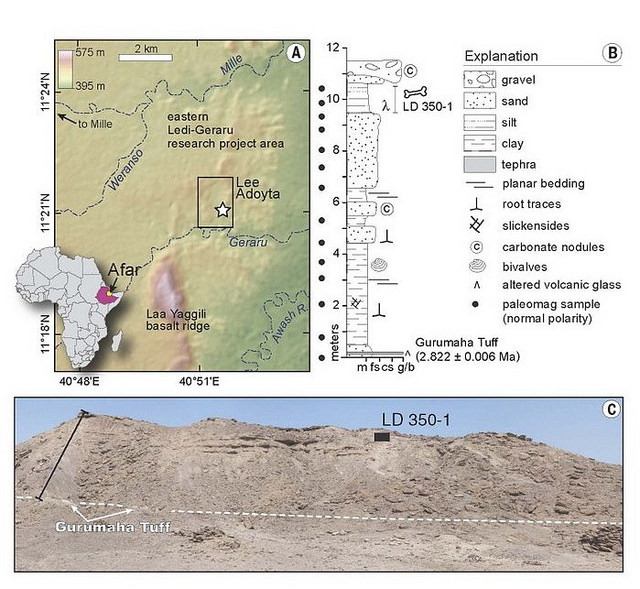 Site, geography, and geological stratification where the fossil partial mandible was discovered. Courtesy Villmoare, et al.
Site, geography, and geological stratification where the fossil partial mandible was discovered. Courtesy Villmoare, et al.
_________________________________________________
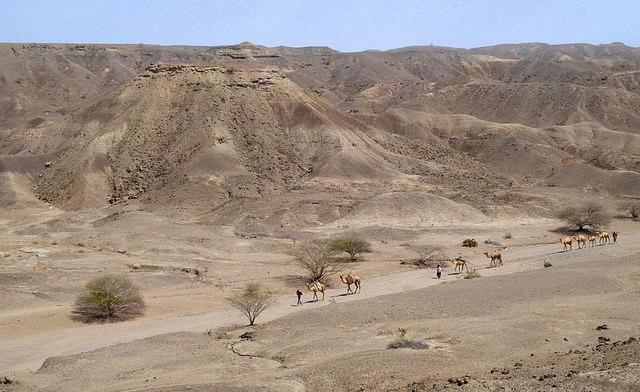 A caravan moves across the Ledi-Geraru project area near the early Homo site. The hills behind the camels expose sediments that are younger than 2.67 million year old, providing a minimum age for the mandible. Courtesy Erin DiMaggio
A caravan moves across the Ledi-Geraru project area near the early Homo site. The hills behind the camels expose sediments that are younger than 2.67 million year old, providing a minimum age for the mandible. Courtesy Erin DiMaggio
______________________________________________
The best reasoning among the scientists of the team led them, at least for now, to a significant conclusion—the mandible came from a Homo. “We have a jaw with teeth that preserves enough anatomy to be quite confident that it does represent an early part of the Homo lineage,” said Kimbel.
Until this discovery, the earliest credible fossil evidence of the Homo genus was dated to about 2.3 or 2.4 million years ago, as represented by the fossil mandible HCRP-UR 501 (see image below), found by the German paleoanthropologist Friedermann Shrenk at Uraha, Malawi. HCRP-UR 501 has been identified as belonging to Homo rudolfensis, an early Homo species that lived roughly contemporaneous with Homo habilis around 2 million years ago.
Could this partial mandible be as old as that? Or even earlier?
Pushing Back the Clock
To date the find, Kaye Reed’s team used multiple dating methods, including radiometric analysis. Geologists Dr. Erin DiMaggio of Penn State and Dominique Garello of ASU took volcanic ash/tuff samples from the layers just above and below the position where the fossil was found at the site. Returning to the lab with the samples, they then used argon 40/39 dating, a high-precision radiometric dating method that measures the decay through time of different isotopes of argon within the ash/tuff. With this, they were able to calculate the ages of nearby associated ancient volcanic eruptions, determining the youngest and oldest dates when the Homo individual could have lived.
The results, according to DiMaggio, “all show that the hominin fossil is 2.8 to 2.75 million years old.”
That made the Ledi-Geraru find the oldest Homo fossil ever found. It predated the earliest known Homo find by about 400,000 years. If the finding holds, the discovery would be nothing less than remarkable.
“In spite of a lot of searching, fossils on the Homo lineage older than 2 million years ago are very rare,” says Villmoare. “To have a glimpse of the very earliest phase of our lineage’s evolution is particularly exciting.”
Moreover, Reed’s team was able to determine the environment in which this early Homo must have lived. The variety of 2.8 – 2.75-year-old animal fossils found in the area indicated that the ancient landscape inhabited by the Homo individual was an open habitat of mixed grasslands and shrub lands with a gallery forest—trees lining rivers or wetlands, likely similar to African locations like the Serengeti Plains or the Kalahari.
“We can see the 2.8 million-year-old aridity signal in the Ledi-Geraru faunal community,” said Reed.
This was significant because some researchers have suggested that global climate change during that time created an environment of climate variability and aridity, triggering evolutionary changes in many mammal lines, including early humans. “But it’s still too soon to say that this means climate change is responsible for the origin of Homo,” says Reed. “We need a larger sample of hominin fossils and that’s why we continue to come to the Ledi-Geraru area to search.”
__________________________________
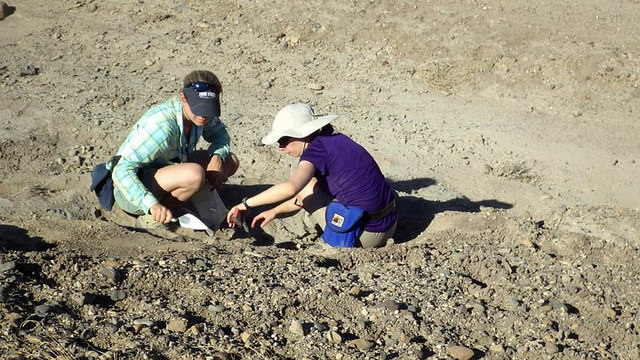 Geologists Dr. Erin DiMaggio of Penn State (left) and Dominique Garello (ASU, right) sample a volcanic tuff near the early Homo site in the Ledi-Geraru project area. Credit J. Ramón Arrowsmith
Geologists Dr. Erin DiMaggio of Penn State (left) and Dominique Garello (ASU, right) sample a volcanic tuff near the early Homo site in the Ledi-Geraru project area. Credit J. Ramón Arrowsmith
_______________________________________________
Homo Who?
The next million-dollar question related to the identity of the species to which the fossil could be assigned. Was it Homo habilis, Homo rudolfensis, or something else?
It is much too soon to say, according to the scientists. More information is needed, not the least of which would be more fossil finds. Nevertheless, according to Villmoare, “what is special about this jaw is not only the date, which is much older than any specimen of Homo known until now, but that it has a unique combination of traits, from the height of the mandible to the shape of the teeth that make it clearly transitional between Australopithecus and Homo,” said Villmoare. “It would not be a direct ancestor, but we are arguing that the population from which this mandible came is ancestral to later Homo, which was in turn ancestral ultimately to us. So it is on our lineage fairly deep.”
Like most research in this area, discovery and study are producing far more questions than answers. But clues and signs are beginning to emerge that may help paint a picture of human evolution at the “evolutionary divide” between the more ape-like Australopithecines and our more directly ancestral Homo line.
“The fossil record in East Africa between 2 and 3 million years ago is very thin,” says Villmoare, “and there are relatively few fossils that can inform us about the origins of the genus Homo. However, this is one of the most interesting periods in human evolution, because during this poorly- known period, humans made the important transition from the more ape-like Australopithecus to the more modern adaptive pattern seen in Homo.”
“We’re beginning to narrow the time,” added Kimbel, “not only as to the origin of the Homo lineage, which now predates 2.8 million, but to the time when it is likely that these two separate lineages of early Homo could have evolved…….the precise nature of the transition, for example whether it was a gradual transformation along a lineage, or a rapid divergence of lineages, or whether the early changes in the teeth and jaws were accompanied by changes in other systems, such as brain, or technology—these things are unknown still.”
The research team plans to continue their search for additional Homo fossils in the area of the find, hoping to shed additional light on the specimen and ultimately determine a suggested species designation.
______________________________________
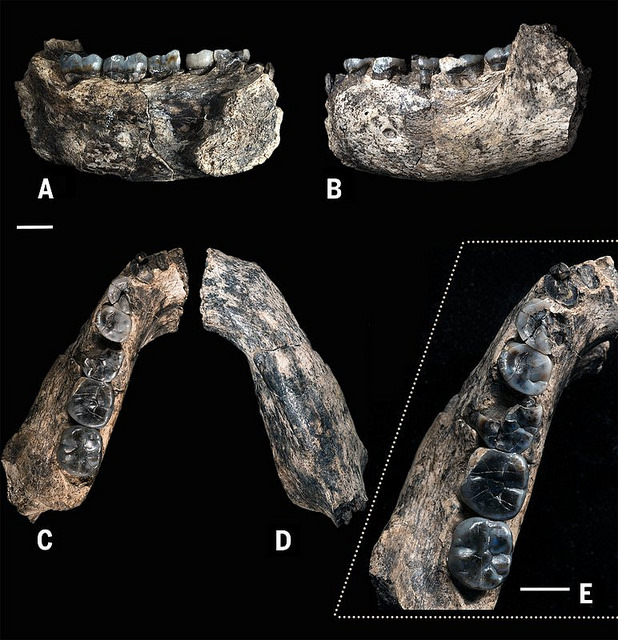 Close-up images of the Ledi-Geraru partial mandible, as seen from different angles and perspectives. Courtesy William Kimbel
Close-up images of the Ledi-Geraru partial mandible, as seen from different angles and perspectives. Courtesy William Kimbel
________________________________________________
Going Forward
For Sonia Harmand and her team at the Lomekwi site, the remarkable stone tools found west of Lake Turkana, like the Ledi-Geraru fossil finds in Ethiopia, will likely have much more to say about the hominins who inhabited eastern Africa during the critical transition between Homo and Australopith some three million years ago.
“We are in the process of looking at the surfaces and edges of the tools under microscopes and with laser scans to try to reconstruct how they were used, and [we are] also studying the sediment in which they were found to search for trace elements or residues of any possible plant or animal tissues that could be left on them after use.” Moreover, says Harmand, the site is still under excavation, with many more stone tools left to unearth.
Perhaps most significant of all, the Lomekwi scientists, like the Ledi-Geraru scientists, suggest there is an even older horizon to be discovered.
“The Lomekwi tools are sophisticated enough that they are likely not from the first time a hominin tried to knap a stone tool,” concludes Harmand. “We think there are older, even more rudimentary stone tools out there to be found, and we will be looking for them over the coming field seasons.”
_________________________________________________
*Harmand, Sonia, et al., 3.3-million-year-old stone tools from Lomekwi 3, West Turkana, Kenya, Nature, Vol. 521, 21 May 2015.
Quotations related to the Lomekwi finds were sourced from interview questions posed by Popular Archaeology to Jason Lewis and Sonia Harmand of the West Turkana Archaeological Project, Turkana Basin Institute, and from subject press releases by the project participating institutions.
Quotations related to the Ledi-Geraru find were sourced from transcripts of the subject AAAS press conference conducted on March 4, 2015 in Washington, D.C.
_________________________________________________





